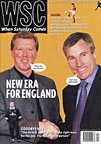 The council wants to build Hull a new ground. David Lloyd, rugby league and crashing phone shares stand in the way Craig Ellyard reports
The council wants to build Hull a new ground. David Lloyd, rugby league and crashing phone shares stand in the way Craig Ellyard reports
Prior to the Taylor Report, Hull City’s Boothferry Park was one of the newest football stadiums in the country. Yet even then, though barely 50 years old, the ground once described as the Wembley of the north was but a neglected shell of its former self. After Hillsborough, new and improved stadiums sprang up all over the country, yet Boothferry and its incumbent club continued to rot. Now, though, a bright future of shiny plastic seats and a trendy new super stadium awaits City supporters. Possibly.
The idea of a “super stadium” in Hull was first mooted by David Lloyd, who saw the potential in having the city’s two main sports clubs, the Tigers and the eggchasing Hull FC, under the same roof. After buying both clubs Lloyd was in a position to realise his dream.
“We’re looking at setting up what the Americans call a leisure city,” he said. But Lloyd’s diplomatic skills (“the people of Hull are living in the dark ages,” he proclaimed) proved too much of a handicap when it came to winning the hearts and minds of the public, and the southern upstart was soon run out of town.
His dream remained though and pressure was heaped on the council to provide tangible support, finally, for the city’s five professional sports teams. Hitherto the city leaders had always resolutely refused to back any of the clubs, except the ice hockey team, whose former council patronage was the controversial and wasteful consequence of one man’s ego.
But now, fantastically flush after the £300 million sale of the municipally owned telephone company, the council has decided to act. They plan to celebrate the Tigers’ near 100 years of monumental underachievement by building a 30,000 capacity stadium in a city centre park, while developing the grounds of Hull’s two rugby league clubs to act as community sports centres in either side of the city. The “super stadium” will be shared by Hull City and Hull FC, with the new facilities hopefully sparking some overdue success for the city’s pair of “sleeping giants”. The notional completion date of the ambitious project is 2003, but already there are problems.
Apart from the inevitable “not in my back yard” protests and fears of increased traffic, the council has said the project won’t go ahead unless it receives a written undertaking from Hull City that the club will move to the new stadium. Disagreements over the financial split from retail and catering outlets, and City’s determination to buy Boothferry Park back from Lloyd, mean the football club has not guaranteed its co-operation. Nevertheless, it’s accepted the Tigers will eventually have no choice but leave their dilapidated home.
Quite what the new stadium will look like, however, is another live issue. The supporters of Hull FC, always a parochial lot, maintain the proposed stadium is too big and that it must feature terracing. Of course the problem is that terracing and Premiership (or even First Division) football, no matter how unlikely that seems for Hull City at the moment, just do not mix.
Terracing would restrict the stadium’s potential so greatly that it would stifle any lingering hopes of progress Hull City still harbour. The crux of the rugby fans’ argument is that a small crowd in a small ground is better than a large, near-empty stadium for a Third Division game. It’s easy to see their point. For Hull FC 10,000 gates are a distant memory, and a small ground would help magnify the limited atmosphere which two men and their whippets can generate.
Raging residents, traffic jams and unambitious rugby clubs can all be overcome but, as ever in Hull, finance is proving more of an obstacle. When the council sold off the phone company it retained a significant shareholding as a “nest egg”. Unfortunately, those shares have plummeted and suddenly spending £35 million (and rising) on a stadium for two underachieving teams is rapidly losing its appeal. Unsurprisingly, doubts linger among many City fans that the new stadium will ever be built.
The council seems determined to see the project through. But as one cynic said after a recent City match: “This is Hull. I won’t believe it until it’s built. And even then I’ll need convincing.”
From WSC 166 December 2000. What was happening this month